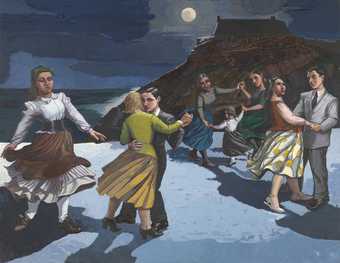
Paula Rego
The Dance (1988)
Tate
She first won acclaim in Portugal with semi-abstract paintings that sometimes included collage elements culled from her own drawings. Their satiric wit and verve of line, sometimes applied to violent or political subjects revealed gifts for story-telling that had been awakened in her as a child by folk-tales related by a great-aunt. In 1976 Rego returned to London with her husband, and in the late 1970s she turned from collage to drawing directly in acrylic on paper. Using an essentially graphic style reminiscent of comic strips, she continued to produce figurative pictures that were spontaneous narratives rather than illustrations to literary texts. Her characters often took the form of animals for satirical effect. She developed a greater freedom and range of colour in her drawings, which inclined them more towards painting. In 1986 she turned to a naturalistic idiom with strongly modelled figures and a consistent light source, often in interior settings as in Snare (1987; Brit. Council Col.); similar subjects were treated in prints which effectively combined etched outlines with tonal gradations of aquatint. These psychologically charged presentations of human dramas, based in part on childhood memories, won her a wide and admiring audience. In 1989 her largest painting to that date, The Dance (2.13×2.74m), was bought by the Tate.
